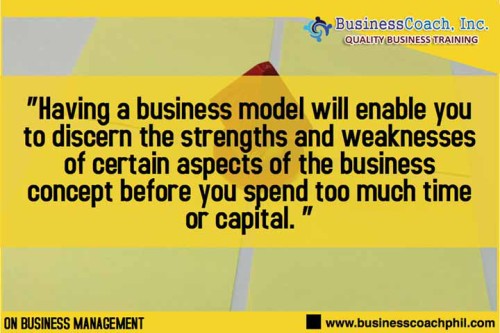Landlines: (02) 8.727.56.28 / (02) 8.569.78.84 /
(02) 8.569.46.90 / (02) 8.727.88.60
Mobile Nos: Globe: 0915.205.0133 / Smart: 0908.342.3162 / Sun: 0933.584.7266
The Vital Role of the Business Model
In starting a business, the right practice is to come up with a business model before writing your business plan. A business model focuses only on the basic ideas and process of how you will be earning your profit. You must first have a business model, at least, in your mind, before you can write a coherent business plan.
Having a business model will enable you to discern the strengths and weaknesses of certain aspects of the business concept before you spend too much time or capital. You can have an overview of the heart of the business without the peripheral parts that are not as significant. A business model is not just a small business plan. It is an initial test of viability.
Although there are many business models, they are far fewer than business plans since there is an unlimited number of business plans you can make from a single business model. Business models are also less detailed and more concise than the usual business plan. A good analogy is that business models are like story lines or plots while business plans are like movie scripts.
The truth is that business models, unless you are in the high-tech industry, are usually generic and it is up to the entrepreneur to find what component in the business model they can have or can create a competitive advantage. If after making a business model, you find no significant roadblocks then you can proceed to drawing up a business plan.
To better appreciate the utility of finding the ideal business model, I hereby, describe some business models that are currently popular and profitable.
A fine example of a business model is franchising. In this model, some franchisors offers a turnkey system, brand name recognition, economies of scale, and proven profitability, among other things in return for royalties and other income from franchisees.
The razor and blades business model practically gives away razors to make money on the blades that must be bought later on. You rely on subsequent sale of supplies for your profit. Prime examples of this are the desktop printer companies who offer printers at an extremely low price and then earn their true profit on the ink they sell.
A very promising type of business model is the “servitization of products”. This is due to the increased role of service in adding value to product offerings. Services packaged along with your products will increase revenues. Nowadays computer companies rarely make good profits on the hardware they sell. The bulk of their income comes from the services like maintenance, software, financing, consultancy, business process outsourcing, etc.
There are many more business models and new ones are being invented but whatever model you select, you must know how to make it work. Here are some tips to make your business model a useful tool in your planning:
- Have a strong customer value. There must be a compelling advantage in choosing your product or service over their current vendor. Having only a slight edge may not be sufficient to change established habits and relationships.
- Obtain the current costs of your major inputs. Get the wholesale costs of the items or inputs that will go into the product or service you will be selling.
- Establish the likely selling price of your product or service. Research the prevailing market prices of similar products or service. If the item or service is truly unique then conduct market research to have a realistic projection. This data along with the costs will help you forecast your margins.
- Have a business model specific enough to be useful. This requires some analysis as crucial differences may not be readily apparent. A traditional drugstore is very different from a generics drugstore not only in the product assortment they carry but also in the marketing. Therefore, it will be necessary to specify the type.
- Consider disruptive technologies. For example, if your business model is a clothing store, then consider how much internet based sellers will erode potential sales.
- Know the costs of acquiring a customer. Find out your costs of obtaining sales. This is one of the most important factors to consider as often, too much capital is spent for insufficient sales.
- Study if your business model is sustainable. See if demand for your product is probably not just a fad. Consider too if your key selling point is not too easily copied.
Coming up with a good business model is the first step in planning a business. It is also the most critical. Here you must expend the most creative effort as this is where the vital strategic decisions are decided. When you have a great business model you have built a solid foundation for a profitable business.
*Originally published by the Manila Bulletin. Written by Ruben Anlacan, Jr. (President, BusinessCoach, Inc.) All rights reserved. May not be reproduced or copied without express written permission of the copyright holders.
You might also like:
Starting a Business While Still Employed »
Business Lessons from Sun Tzu »
How to develop a good personal brand »
Myths About Starting a Business »
The Seven Common Pricing Mistakes »



